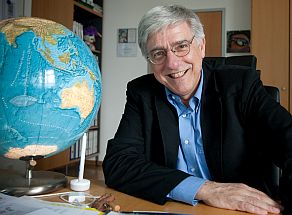Mid- and high-latitude northern hemisphere continues to absorb atmospheric carbon dioxide

Prof. Martin Heimann Photo: Martin Jehnichen
Only about 45% of the anthropogenic CO₂ emissions from the burning of coal, oil and gas and from deforestation accumulate in the atmosphere, while the remaining 55% are taken up by land and ocean in about similar proportions. This global partitioning has been remarkably stable over the last 60 years of accurate observations.
Since about 30 years ago, increasing evidence has shown that a significant fraction of the CO₂-absorbing ecosystems, so-called sinks, are located in the northern extra-tropics. These are primarily the mid-latitude vegetation, boreal forests and the north Pacific and Atlantic oceans.
The characteristics and the remarkable stability of this “northern hemisphere CO₂-sink” has now been discussed in a symposium with 120 climate scientists, among them renowned experts from 4 continents, at the Max Planck Institute for Biogeochemistry in Jena, Germany.
The sink function of the Northern hemisphere relies on both the vegetation of the land surface and the oceans.
Vegetation incorporates CO₂ through photosynthesis and this uptake increases with higher CO₂ concentrations, an effect known as CO₂ fertilization. However, this process is also modified by the availability of water and nutrients. Furthermore, changes in land management, in particular regrowing forests in northern mid-latitudes also contribute to CO₂ uptake by land vegetation.
Conversely, rising temperatures enhance soil respiration which reduces the net CO₂ absorption. In addition, high-latitude warming fostering permafrost thawing will particularly enhance emissions of CO₂ and methane, both powerful greenhouse gases. While the latter high-latitude fluxes are currently still very small, they are expected to accelerate with increased warming in the Arctic, thus constituting an important positive climate feedback.
While many of these complex land processes are still poorly known, powerful research tools have been developed over the last decades providing a much clearer understanding of individual causal links. Among these are high resolution analyses from satellite observations, global inventories using radiocarbon as well as substantial improvements in terrestrial biosphere models including comprehensive descriptions of nutrient and water cycles.
The ocean sink for CO₂ has also substantially increased in the last few decades as documented by an impressive array of new observation platforms, including automated measurements on ferries and freighter ships, autonomous floating devices and depth profile moorings. These new methodological advances provide a much richer knowledge of ocean carbon cycling than heretofore possible. Of particular interest is the tantalizing finding that the ocean sink, while increasing, also exhibits much stronger decadal variability than previously thought.
Given the enhanced view of the complex carbon cycle processes on land and in the ocean, it is remarkable that overall the global CO₂ sink has remained rather stable so far, at least on a decadal scale. On shorter time scales, however, interannual variability driven by climate fluctuations, such as El Niño events, is clearly visible in the observations. It is still an open question whether these short term variations can be taken as an analogue for understanding and quantifying the response of the global carbon cycle to the longer-term global warming expected during this century.
A tribute to Prof. Martin Heimann as an outstanding climate researcher
The scientific symposium on the Northern hemisphere sink was dedicated to Prof. M. Heimann, who retired as Max-Planck director at MPI-BGC, to honor his seminal role in the research field. As a physicist specializing in atmospheric greenhouse gases, he pioneered comprehensive global climate models, established networks of defined atmospheric measurement stations, substantially improved high-precision and isotopic measurement procedures, and co-initiated the European ICOS network. Prof. Heimann’s influential role was honored in the symposium lectures of the international experts, many of whom he mentored during his fruitful career.
Following his PhD at University of Bern, Switzerland, Prof. Heimann worked as research assistant with Charles D. Keeling at the Scripps Institution of Oceanography, UCSD, La Jolla, U.S.A. He pro-ceeded to become a group leader first at the Max Planck Institute for Meteorology, Hamburg, and later at the Max Planck Institute for Biogeochemistry in Jena, where he was promoted to Max Planck Director of the Department Biogeochemical Systems in 2003. M. Heimann was elected a member of the Academia Europaea and Academician of the International Eurasian Academy of Sciences, received the medal of A.M. Obukhov Institute of Atmospheric Physics at the Russian Academy of Sciences, accepted an honorary professorship at Friedrich-Schiller University Jena, was awarded the Heinrich-Greinacher-Preis and contributed to the Nobel Peace Prize for IPCC in 2007. M. Heimann is now looking forward to continuing his successful research as Emeritus Director at MPI-BGC and visiting professor at University of Helsinki, Finland.
Media Contact
More Information:
http://www.bgc-jena.mpg.deAll latest news from the category: Earth Sciences
Earth Sciences (also referred to as Geosciences), which deals with basic issues surrounding our planet, plays a vital role in the area of energy and raw materials supply.
Earth Sciences comprises subjects such as geology, geography, geological informatics, paleontology, mineralogy, petrography, crystallography, geophysics, geodesy, glaciology, cartography, photogrammetry, meteorology and seismology, early-warning systems, earthquake research and polar research.
Newest articles

Security vulnerability in browser interface
… allows computer access via graphics card. Researchers at Graz University of Technology were successful with three different side-channel attacks on graphics cards via the WebGPU browser interface. The attacks…

A closer look at mechanochemistry
Ferdi Schüth and his team at the Max Planck Institut für Kohlenforschung in Mülheim/Germany have been studying the phenomena of mechanochemistry for several years. But what actually happens at the…

Severe Vulnerabilities Discovered in Software to Protect Internet Routing
A research team from the National Research Center for Applied Cybersecurity ATHENE led by Prof. Dr. Haya Schulmann has uncovered 18 vulnerabilities in crucial software components of Resource Public Key…




















